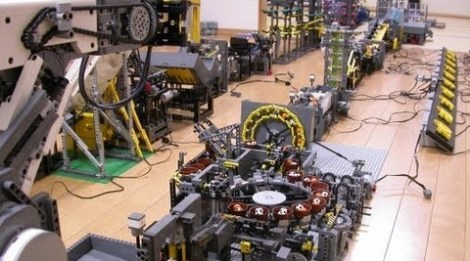
Looking at this 17-stage Great Ball Contraption makes us think that [Skiyuky] should be working in industrial automation. The build, which has been assembled from an untold volume of LEGO parts, moves a reservoir of round plastic balls around a circuit. Each module exhibits a different mechanical way of handling the parts. It’s certainly not the first GBC we’ve seen, but the previous offering combined stages from many different makers. [Skiyuky] built this one all himself over the last two years.
The video after the break starts off at the main depository of tiny soccer and basketballs. To help illustrate how long it takes to move around the entire circuit [Skiyuky] adds a red and blue ball which are both easy to spot. From there it’s a Willy Wonky type of ride through all manner of contraptions. We’re struck by accuracy and efficiency with which all of the stages operate.
[Thanks Fozzyvis]















win
Sweet! I especially appreciate the basketball flippers. Now load it with everlasting gobstoppers!
So useless and so cool!
It looks like what would have happened if Rube Goldberg had designed the Krell power plant in the movie “Fobidden Planet”
the blue one made a jack pot!
I want to have one of these.
Cool but I was disappointed that it didn’t sort them by colour at some point.
Spending a fortune on legos to move balls in a circle.
Not sure what to think.
Buying an arduino to blink an LED.
You just made my day, thank you xD
Absolutely mesmerizing! This is one incredible build! Excellent work!!!
Wicked! This makes me wish I did not sell all of my Lego now ;-(
Absolutely amazing!!! I wish I had 600 hours of time to spend on a fun project.
haha, its sad im still learning to make my nxt behave on its own, let alone making 2 work as one robot arm
Next challenge: A lego bot that manufactures copies of itself…
It would be over-the-top-awesome if they interpreted the different balls as 1’s or 0’s. Then you could implement it as a Turing machine with functional units that processes random instructions/data.
Absolutelymegastupendouslyawesomeinspiringmagicwidgetfuckeryofthemostgodlikestatuseverseen. Pretty cool people. Love it lots.
This is awesome. I wish I had this guys problems…….endless supply of legos(most of which I have never even seen) and tons of free time. That would be the life.
Cost of Legos: Thousands!
Level of awesomeness: Off the scale!!!
Amazing! It really takes some work to make the movements accurate so balls are transferred without falling. It was challenging for me to make just one stage as a trial. The caterpillar tracks are very useful for moving balls up and down and they are thankfully easy to get without having to buy the bulldozer kit, etc.
Brilliant
Shameless plug – while not nearly as extensive, I had built and filmed this trio of GBC a few years back. https://www.youtube.com/watch?v=n66N0A2VRyM
Most. Awesome. Gumball. Machine. Ever.
I wish someone could give this guy a pill camera to drop in a clear ball – and send it through the machine.
You just need a round pill cam that is inside a round hollow shell, with a gliding fluid in the space between cam and shell. The center of gravity of the cam inside at the bottom and it will stay parallel to the horizon. though the inertiam will be a problem at this scale.
Kaj:
It could be an interesting prospect if you could find a way to keep the camera steady or at least have a high enough frame rate and resolution to stabalize the image.
Maybe the best bet would be to scan the whole thing with a few kinects over one whole cycle and then take enough high resolution photographs to build an almost perfect digital version. Put on a pair of vr goggles and enjoy the ride (:
I bet this guy faps to How It’s Made.
Which is OK, because so do I.
*pause*
Oh – oh yes. Comment gold right here.
*resumes fapping to How it’s Made*
incredibly amazing!!
Makes me wonder what the MTBF is for a lego motor :D
this is really cool, i get a flashback to childhood happy playing with Technics lego ;)
building instructions for these modules are available on http://www.planet-gbc.com